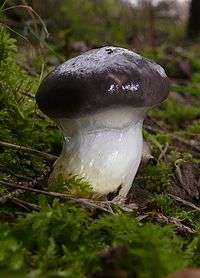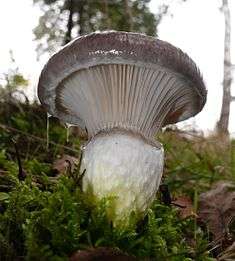Gomphidius glutinosus
| ||||||||||||||||||||||||||||||||||||||||||
Gomphidius glutinosus, commonly known as the slimy spike-cap, is a gilled mushroom found in Europe & North America. Although it has gills, it is a member of the order Boletales, along with the boletes. The fruiting bodies sprout in pine, fir and spruce woodland in Europe in autumn. Initially, are completely covered with a slimy veil, breaking through to reveal a greyish or brownish-capped mushroom with decurrent greyish gills which sometimes resembles a child's top. Opinions differ on the suitability of this mushroom for the table, some guides hold it in high regard, while others view it with caution.
Taxonomy
Gomphidius glutinosus was initially described by German mycologist Jacob Christian Schäffer as Agaricus glutinosus in 1774, before the father of mycology Elias Magnus Fries gave it its current genus and binomial name in 1838. The genus name is derived from the Greek 'γομφος' gomphos meaning "plug" or "large wedge-shaped nail".[1] The specific epithet glutinosus is the Latin adjective "sticky".[2]
Alternate common names in Germany are Kuhmaul "cow snout",[2] and Rotzer.[3]
Description

Said to resemble a child's top, the mushroom has a dark brownish or greyish cap up to 12 cm (4.5 in) in diameter; it has a central boss and an inrolled margin, and is initially convex and later flattens and may develop blackish markings.[2] As with other members of the genus, the whole mushroom is often covered with slimy or sticky veil when young. The fungus tears free of the veil as it grows, leaving some strands and an indistinct ring.[3] The stipe is 3.5–10 cm (1.4–4 in) high and 1–2 cm wide, and is white with a greyish tint and often flushed yellow at the base. The whitish flesh may have a wine-coloured tinge and has little taste or smell. The widely spaced decurrent gills are waxy in texture, with a hairy surface from the cystidia.[3] Sometimes branched, they are initially whitish, then grey and later blackening with spores, and the spore print is brownish-black. The large spores are spindle-shaped and measure 17–20 μm long by 5.5–6 μm wide.[4]
Brownish specimens may be mistaken at a glance for Suillus luteus, but a quick look under the cap will see there are gills rather than pores.[5] Another similar-looking species is Hygrophorus hypothejus, found in similar habitat though with yellow gills which do not separate from the cap.[4][6]
Distribution and habitat
Gomphidius glutinosus is found in Europe & North America where it occurs in autumn under pine and fir trees, both in natural woods and plantations, generally singularly or scattered.[5] Fruiting bodies sprout in the autumn.[4]
Ecology
Like other members of the family Gomphidiaceae, Gomphidius glutinosus has been thought to be ectomycorrhizal, forming symbiotic relationship with their host trees.[7] However, there is now evidence that many (and perhaps all) species in this group are parasitic upon ectomycorrhizal boletes, in relationships that are often highly species-specific, such as Gomphidius roseus upon Suillus bovinus.[7]
Two specimens of Gomphidius glutinosus were found in Brechfa Forest on the 25th Of July 2009. The only boletus to be found in the vicinity was Suillus grevillei.
G. glutinosus is a "hyper-accumulating" fungus that absorbs and concentrates elements such as cesium more than 10,000-fold over background levels. This property can be used to decontaminate sites contaminated with radioactive cesium-137.[8]
Edibility
Opinions differ on the suitability of this mushroom for the table, some guides hold it in high regard,[6] while others view it with caution.[4] Gomphidius glutinosus has a mild flavour well-suited for cooking with other mushrooms, and in soups and stews.[3] It not suited for drying. Removing the slime and skin of the cap is recommended as soon as possible after picking. Maggots only rarely attack this species.[3]
References
- ↑ Liddell HJ, Scott R (1980). Greek-English Lexicon, Abridged Edition. Oxford University Press, Oxford, UK. ISBN 0-19-910207-4.
- 1 2 3 Nilson S & Persson O (1977). Fungi of Northern Europe 1: Larger Fungi (Excluding Gill-Fungi). Penguin. p. 112. ISBN 0-14-063005-8.
- 1 2 3 4 5 Zeitlmayr L (1976). Wild Mushrooms:An Illustrated Handbook. Garden City Press, Hertfordshire. pp. 93–94. ISBN 0-584-10324-7.
- 1 2 3 4 Roger Phillips (2006). Mushrooms. Pan MacMillan. p. 270. ISBN 0-330-44237-6.
- 1 2 Haas, Hans (1969). The Young Specialist looks at Fungi. Burke. p. 52. ISBN 0-222-79409-7.
- 1 2 Lamaison, Jean-Louis; Polese, Jean-Marie (2005). The Great Encyclopedia of Mushrooms. Könemann. p. 34. ISBN 3-8331-1239-5.
- 1 2 Olsson, Pal Axel; Münzenberger, Babette; Mahmood, Shahid; Erland, Susanne (November 2000). "Molecular and anatomical evidence for a three-way association between Pinus sylvestris and the ectomycorrhizal fungi Suillus bovinus and Gomphidius roseus". Mycological Research 104 (11): 1372–1378. doi:10.1017/S0953756200002823.
- ↑ Stamets, Paul (2011-04-16). "How Mushrooms Can Clean Up Radioactive Contamination - An 8 Step Plan". Permaculture - practical solutions for self-reliance (Permanent Publications). Retrieved 2013-10-24.
External links
| Wikimedia Commons has media related to Gomphidius glutinosus. |
